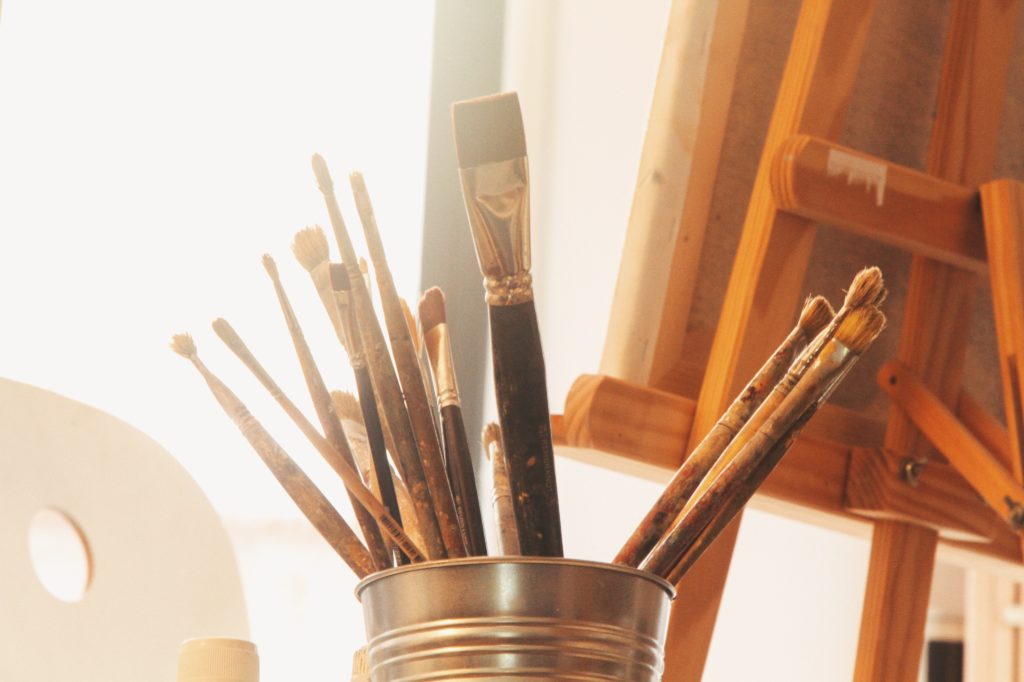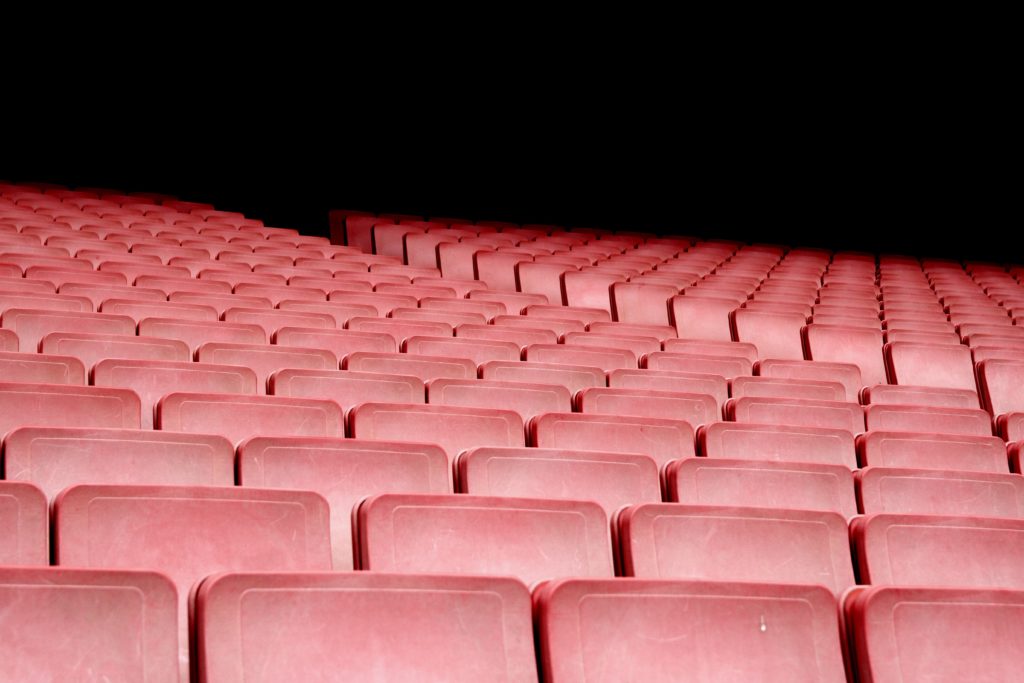An Audience Everywhere
This may sound strange, but I’ve been thinking a lot lately about the role of the audience. As an artist, how does the audience, or simply the idea of an audience, affect the way in which I create? To be honest, it was Elizabeth Gilbert’s Big Magic plus going to Switzerland plus working on a one-man show that got me thinking about audiences.
If you haven’t read Big Magic, I need you to stop reading these crappy words and go read that instead. It’s a book I’ve read at least half a dozen times and one I feel should be required for all artists. It’s about creative living, so technically it should be required for all creative beings, not only artists. In fact, Liz would argue that “creative being” is a redundant phrase. So, really, everyone should read that book. You get the point. Go read it.

When it came into my life a few years ago, Big Magic opened my eyes and rewired my DNA. Gilbert’s words completely shifted the way I look at myself as an artist. Without being overly dramatic, it saved me from sabotaging my creative life. It was the catalyst for starting this blog, which, by the way, just turned two years old last month. It inspired me to write a TV show script, make a short film, shoot a few episodes of a webseries, start a YA book with a friend, and say ‘yes’ to my creative impulses. Most of the artists in my life have been given a copy of Big Magic or were bullied into procuring their own. It’s that important.
Since reading that book, it has become my compass for navigating the stormy seas of the creative life. The lessons in it are my due north to help me find courage and remind me why I chose this path. So as I stood at the foot of my bed, discarded clothes in every direction, deciding what to pack for a 10-day trip to Switzerland, I knew I needed Big Magic by my side.

The origins of my entire Swiss journey could be traced back to that book if I had the time or desire to do such a thing. I was headed to that neutral Alpine country, with all its cheese and chocolate and wine, for my very own artist residency. I’ve been writing a one-man show and my brilliant friend Sherri agreed to let me stay with her in Geneva while I continue developing it. She’s a genius performer and director whose guidance is like gold. I had to take this opportunity. In reality, I had to create this opportunity.
I settled into my aisle seat on the flight from New York to Reykjavik (who doesn’t love an Icelandic layover). Giddy energy surged through me like a kid on the first day of school. I was embarking on what was to become a once-in-a-lifetime journey. We reached altitude and the pilot turned off the Fasten Seatbelt sign. I immediately jumped up to retrieve Big Magic from my bag. There wasn’t enough space to bring back a morsel of Callier chocolate, but I managed to shove that well-worn hardback into a bag whose seams were on the verge of bursting open.

One of the many things Liz explores in the book is intention. She asks the why. Why do we make things? Why do we, as a species, create pretty stuff that isn’t necessary to our physical survival? Why do we pour time and energy into cave paintings and novellas and tchotchkes? Why did we do art before we did organized agriculture?
Liz is certainly smart enough and a good enough writer to have gone into an academic argument to answer those questions. She could have explored major anthropological theories, complete with charts and citations, that explain homo Sapiens’s bizarre need to make the nonessential. She doesn’t though. Her take is, more or less, we make stuff because it’s fun and it decorates our lives. I love the simplicity of that.
While she doesn’t go into the biological or sociological reasons for making art, she does go into the personal. Why, in the 21stcentury, with our advanced technologies and first world comforts, would someone continue to stubbornly insist on making things just for fun? What reasons does an individual have to make art? She suggests the reasons are selfish.
Liz Gilbert, in fact, insists that creating things, making art, generating the pretty, is a selfish act. She’s adamant about that. Not only is it selfish but it should be selfish. It needs to be. Writing or cooking or drawing or singing or painting or dancing or planting or sewing should be for the pure pleasure of it. Making should serve to please the maker. Simply put, creators have to make art for themselves and no one else.

At one point she begs writers not to “try to help people” with their writing. Your writing, she offers, should seek to help yourself. Even Eat Pray Love, which many people (read: millions) found helpful in their own lives, was written solely to please the author and as a means to process her experience. She says had she written that book with the intention of “helping” others, she would have A) produced a very different book and B) possibly produced a very terrible book.
As a writer, this rings true to me. The act of writing is the act of making sense of the world. I can’t make sense of the world for someone else. I can only do that for myself, with varying degrees of success I might add. As a reader, this also rings true. Whenever I read something that’s intended to “help” people, I’m rarely moved by the words. It doesn’t matter if it’s self-help or a novel or a historical biography. Sure, I may find the content interesting but generally won’t find it emotionally engaging or artistically stimulating.
When I read something that was made for the maker, however, I’m more likely to be moved by it. It’s more likely to reach a deeper level. It may even ‘help’ me. It’s ironic, isn’t it? The more selfishly art is made, the higher likelihood of it igniting something in an audience. Audiences gravitate toward work that is joyfully made verses dutifully made.

The pilot’s voice overhead brought my body back into the plane. We were nearing Iceland and my head was swirling with ideas. Here I was, en route to a Swiss artist residency, flying to the other side of the planet to write a one-man show. Did I really know why I was embarking on this trip? What was my intention for creating this show? Was I doing it only for me? Was I making this for the audience?
I was creating a piece of theatre meant to be performed for an audience. According to Liz, I need to make its creation a selfish act. But is that possible? Can I make something solely for my own pleasure but that is dependent on the presence of an audience? Where do they fit in the equation? Should I ignore them?

I was reminded of one of my early college theatre experiences. While at Georgia State, I had the honor of working with a brilliant director named Andrea Frye. She’d been doing theatre for an eternity and knew everything about everything. She was funny, wise, no bullshit, cussed like a sailor, and cared deeply about her work. I revered her. I feared her. We all did.
She would become one of my most important teachers in those formidable years. I was as green as they come, and I soaked up every word Andrea spoke. To this day I treasure some of her lessons.
Once during a rehearsal, she said that theatre practitioners (a phrase I’d never heard before) must constantly ask: can they see me, can they hear me, do they care. Those three questions must guide every practitioner throughout every stage of the process.
“Can they see me?” is a literal question. Can the audience see my body from where I am on stage? Can they see my face and what I’m doing? Lighting designers, directors, costumers, set designers, in addition to actors, must also ask this question while making theatre. The same is true for the other two questions and everyone involved in a production.
Can they see me? Can they hear me? Do they care?
That seems pretty audience-centric to me. Where does Liz come in? Can I create a piece of art that is selfishly made but still doggedly asks questions about the audience experience? How can I reconcile these two ideas? Both Liz and Andrea have valid arguments that I know to be true. The best theatre keeps the audience at the forefront of decision-making, but the best art is made solely to please the artist.
As the wheels of the plane made contact with the runway at Genève Aéroport, I didn’t have an answer. I only had questions. These certainly weren’t life-or-death questions, but they were worth entertaining as I set out for my self-appointed residency. Do I make stuff for me or for an audience?
That’s when I realized, this isn’t just about art, it’s about life.
It was an a-ha! moment. And I had to ask, who am I creating my life for? Do I make decisions for myself or for an “audience?” I like to think that I’m the auteur of my life, the architect and artist. Every single choice, every single moment, leads to a portrait of that life. Am I writing the story as I want, for me? Or am I writing a story that I hope will please and appease some “audience?” Am I being as deliciously selfish in designing, crafting, building, painting, and decorating my own life?

Sometimes the answer is yes, sometimes the answer is no. Sometimes an invisible audience, who is largely a construct of my own mind, dictates what I wear or post on social media or do for work. This unseen and unseeable audience sometimes tells me what the painting of my life should look like. They tell me how life-paintings are supposed to look and the ways that mine could be more like that.
But, then again, sometimes it doesn’t. Sometimes I do shit for me, and me alone. As I walked toward baggage claim, with my feet on Swiss soil, having spent my own money to get there, for the purpose of writing a one-man show and eating obscene amounts of chocolate, I realized the audience could kick rocks on this one. They wouldn’t be calling the shots. Not on this pursuit. At least, not today.

Check out this week’s photo contributors:
I just requested Big Magic from library. Can’t wait to see the one man show!
It’s such a fun read! Also we love libraries!
What a Beautiful place to go and do your “residency” a place to clear your mind, a place to feed your mind(with Gelato and Chocolate)a place to let go and experience the Zen &Serenity of Switzerland -The perfect Setting to create!! I am Very impressed and Very excited to hear about the finished product! Welcome home Cutie! Love You!!
It definitely replenished my soul! It’s now one of my favorite places.
Agh this is so good! I should read that book!
You haven’t read the book, and Patrick is still talking to you? Wow, he must love you a lot for that kind of special treatment.
I’m nothing if not benevolent.
You should!
“funny, wise, no bullshit, cussed like a sailor…” My mom’s been reincarnated!!
My mom told me once to figure out who we’re imagining when “talking to ourselves.” She realized that most of the time her inner dialogue was directed towards her mother. So sometimes our creativity stems from the impersonal, and sometimes for an imagined audience, even if we don’t consciously realize it. I think it’s the generalized “I want to impress the whole world!” audience that can be the creativity killer.
My main-crush-who-broke-my-heart-by-letting-me-pine-away-for-years-without-ever-telling-me-he-was-gay, Oliver Sacks, writes brilliantly because he’s usually trying to figure things out for himself. In one of my favorites, “A Leg to Stand on,” Ollie (like you and Liz, we’re on a first name basis) ponders his own reactions to a devastating leg injury that took more than a year to heal. His own audience in this case is himself, but he’s so well read and so–I want a word other than creative here, but can’t think of it–he pulls together ideas from all kinds of sources and puts them together in a completely unique way. He’s quoting T.S. Eliot, and Auden, and 19th century doctors, all in an effort to process his own journey. The resulting read is fascinating.
That book helped me in many ways, probably because he was being genuine, and not attempting to help anyone. I’ve read tons of memoirs written for the purpose of helping others, and they’re invariably sanctimonious snooze-fests.
No one right answer here.
I definitely think Grandma shared some similarities with that college director! I love the idea of exploring who our internal monologue is directed toward. Most times I’m probably talking to Oprah. Also, I have to read more Oliver Sacks! I’m ashamed to admit that I’ve only touched a few of his essays here and there. Maybe I’ll go for a deep dive into his leg journey.
The leg journey might be a bit intensive for a first dive; don’t want you getting the bends.
“The Man Who Mistook His Wife for a Hat,” or “An Anthropologist on Mars” are essay collections that might be good starting points. The Anthropologist refers to Temple Grandin, the autistic scientist who’s become famous. Claire Danes played her in a movie.